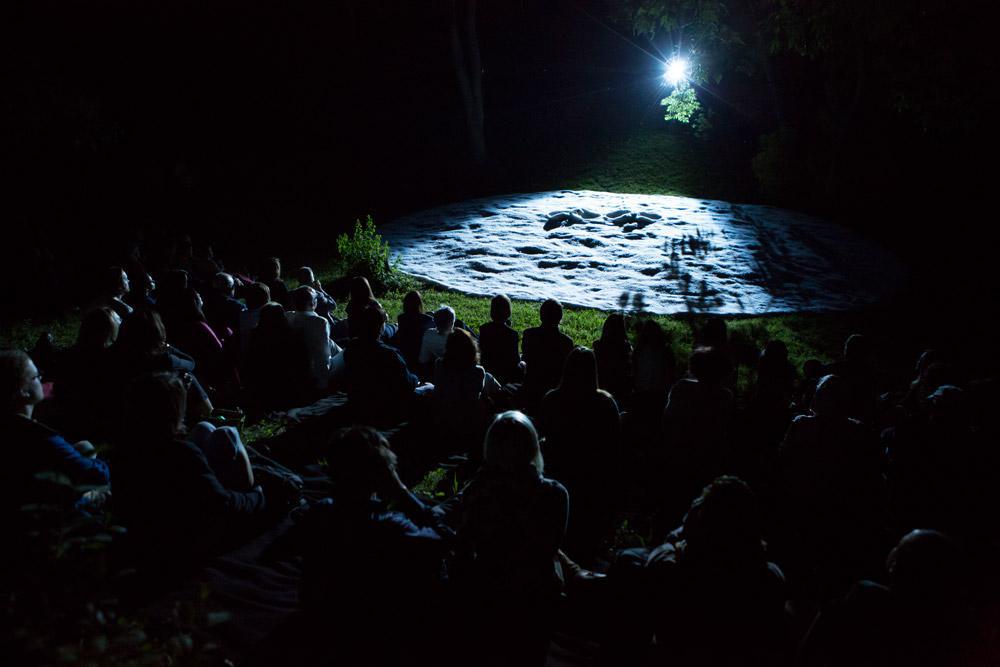Coverage of Terence Koh‘s recent performances at the McMichael Canadian Art Collection have tended to focus on the theme of “bad-boy-makes-good,” describing the Beijing-born, Mississauga-raised artist’s former persona as an all-white-clad enfant terrible of the New York art world (purveyor of gold-plated excrement and whitened sex toys), and his dramatic transition to the very un-dramatic, soft-spoken, contemplative person who came to Toronto last week to create two new works as part of the Luminato festival. In fact, though, there is a consistency to Koh’s story; these new performances (ongoing nightly until June 13) reach back to earlier themes in his art—memory, mortality, the paradoxes and pleasures of embodiment—albeit articulated in softer tones.
Clad in well-worn overalls and grey felt slippers—gone is the albino monkey-fur get-up of yesteryear—Koh charmed his June 7 audience with his modest and heartfelt appreciation of the historic West Coast artist Emily Carr (1871–1945), focusing his remarks on Carr’s ability to capture the moment, her emotional expressiveness, and her spiritual attachment to the land. Honouring her, Koh then led us through the forest to an opening in the woods near the famous burial place of several Group of Seven artists on the McMichael grounds.
Here, he performed a work he calls a way to the light, a tree-planting ceremony in commemoration of Carr. As we gathered around, Koh kneeled on the verge of an open pit, burning sweetgrass, and then reciting Walt Whitman’s poem “Gods.” (“Thought of the Infinite—the All!/ Be thou my God./ Lover Divine, and Perfect Comrade!/ Waiting, content, invisible yet, but certain,/ Be thou my God….”) Rising, and with the help of the assembled watchers, he then planted a pine tree in honour of his artistic ancestor.
It could have gone either way—sham or shamanic—but the tone of sincerity took a gesture that could have felt stagey and made it something memorable and poignant. The tree, as Koh pointed out, will be here long after we are all gone, as will be the legacy of the artist he commemorates. She too, in her art, was always moving toward the light, with Whitman as her constant thought companion.
The themes of death and remembrance are not new to Koh. Even in his glitterati days, his all-white motif evoked the Chinese traditions of mourning in which white is the colour of death—as opposed to the black prevalent in European tradition. His whitened objects, too, suggest European plaster death masks, and the blinding white light of the afterlife. Koh’s past use of his own blood, semen and excrement as artistic materials also seemed to underscore the ephemerality of human existence, our terminal biological condition.
Carr, too, had a fascination with burial and death, often drawing and painting the settler graveyards on Vancouver Island as well as the Native burial sites she encountered in her travels up and down the coast, including the traditional tree burials in which bodies were boxed and suspended high in the forest branches, or contained within the tops of burial poles. This was likely a fascination born of her own melancholy, soulful disposition, but it also may have reflected her colonial identity as a first-generation Canadian, adrift between her family’s allegiances to the old English ways and the allure of the frontier. Where you choose to be buried is where you understand yourself to be most deeply rooted. Like Koh, whose family has also migrated great distances, Carr belonged nowhere absolutely, or, as Koh corrected me, “she belonged everywhere.”
In planting Carr’s tree, Koh has provided a kind of alternate resting place for his legendary Canadian forebear. Carr’s physical remains are buried in Ross Bay Cemetery in Victoria, on a bluff near her beloved Clover Point and Beacon Hill Park. Through this gesture, though, Koh has symbolically rooted Carr in the east as well, near—but not too near—the company of Group of Seven artists like Lawren Harris, who provided her with such critical encouragement in her later life. Though she loved the west, and has been its prime artistic interpreter, it was her contact with the east that reignited her creativity after a 15-year hiatus, driving her to explore new artistic frontiers.
After the tree-planting, Koh led the group to a further destination, deeper in the woods: a tree-ringed hollow in which a large circle of what appeared to be snow was laid. Once the twilight dimmed to darkness and the crowd grew quiet, a spotlight was switched on, providing a solid beam of light that suddenly illuminated the field of white, effectively blanking out the greenery all around us, and casting our memories back to winter. From behind this light, a small boy and girl approached us, clad in white and holding hands. When they arrived at the centre of the circle they lay down, and, in methodical, sweeping movements, began to make snow angels, a simple gesture that evoked childhood magic. Inspired by a moment in a Margaret Atwood story, Koh reconstitutes in performance a literary image that has lived in his mind for decades, charged too, perhaps, by memories from his own Canadian youth. Now that moment is planted in us too.









